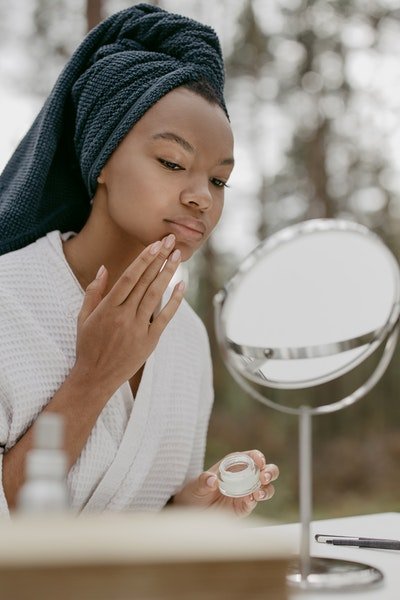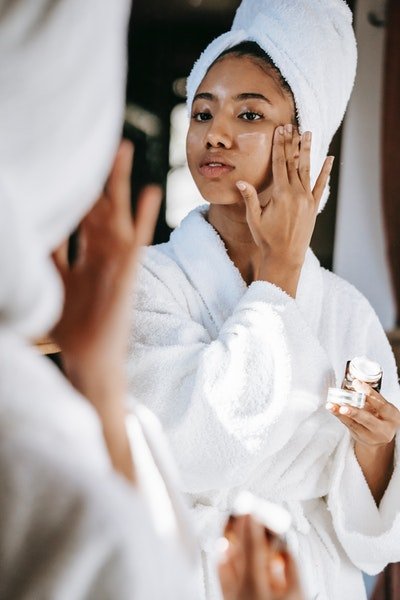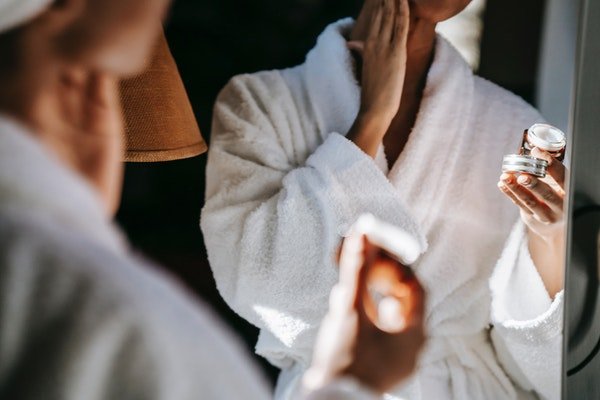You don’t have to look far to understand that everything in the world has a color. Some things are matte, others incandescent, and there are those that are entirely colorful. In life, color appears for several reasons: some species in nature use different shades, for instance, to protect themselves from predators. Others simply display their many beautiful hues wherever they go.
In the end, in every leaf, every stone, and every living being there’s a pigment (or hundreds) giving it color. In humans, this pigment is called melanin. The skin, hair, eyes, and mucous membranes contain varying amounts of melanin, which is produced in a specific type of cell: the melanocyte.
In Black skin, these cells contain more melanin. It is our genetic heritage that determines the production of this pigment, thus giving us a great diversity of skin tones.
According to the Brazilian Institute of Geography and Statistics (IBGE), color/race is a self-declared variable that can be divided into five categories: white, Black, brown (mixed-race), Indigenous, or yellow (Asian). The most recent data from the Institute shows that Blackness—the ethnic aspect that includes both brown and Black individuals—is self-declared by about 56.20% of Brazil’s population.
The proportion of Brazilians who self-identify as Black was the only group that increased in all regions of the country between 2015 and 2018, according to the National Household Sample Survey (PNAD) conducted by the Institute.

However, despite this growing representation, it’s still not always easy to find precise information about Black skin, its structural, biological, and functional differences, its peculiarities, and necessary care. Find more details throughout the article.
- Characteristics of Black skin
- Hyperpigmentation and hypopigmentation
- Acne on Black skin
- Other dermatological aspects
- Ideal skincare for Black skin
Characteristics of Black skin
Black skin presents numerous physiological peculiarities that highlight its beauty and also require slightly different daily care, having specific needs, such as:
- In the epidermis, for example, the stratum corneum (the outermost part of the skin) has more layers but the same thickness as white skin;
- And, precisely because this stratum corneum is more compact, it is suspected that Black skin has lower skin absorption (in other words, less penetration of substances from the external environment, through the skin, into the body);
- In terms of melanin quantity, it is higher, but there is no difference in the number of melanocytes (cells that produce melanin).
- This higher amount of melanin gives Black skin a sun protection factor against UV rays, with an average protection factor against UVB rays (responsible for burns and redness after sun exposure) of 13.4 compared to 3.4 for white skin;
- Another observed point is that Black skin has a 2.5 times higher rate of spontaneous desquamation compared to white skin, which specialists believe could explain a greater predisposition to dryness.
There is also evidence that Black skin shows a greater transepidermal water loss. This process refers to the amount of water that passively evaporates through the skin into the external environment, making it more prone to cracks and dryness.
On the other hand, the pH of the skin’s surface and the microflora (that is, the micro-organisms, fungi, and “good” bacteria on the skin) seem to be lower in number.
Other differences that can be emphasized:
- Dermis thickness is the same in whites and Blacks, but in Black individuals, collagen fiber bundles are smaller and distributed more parallel to the epidermis;
- Superficial blood vessels are more numerous in Black skin;
- Fibroblasts (cells that provide elasticity and strength) are larger and more hyperactive, and they also produce more collagen. This makes the skin firmer and slows the appearance of aging signs;
- The most common issues in Black skin are pigmentation imbalances (dark and white spots, especially after healing), folliculitis (infection in the hair follicles), and keloid (a disproportionate, raised scar that forms after a cut in the area).
Hyperpigmentation and hypopigmentation
Famous for its unique tone and beautiful shades, Black skin, like all skin types, also has its vulnerabilities. One of the greatest concerns is its tendency to develop spots: the dreaded pigmentary disorders. These refer to both hyperpigmentation and hypopigmentation (or achromia).
When we talk about this type of pigment imbalance, it means that anything that injures Black skin can, during healing, develop spots—a kind of exaggerated response by the melanin. Thus both hyperpigmentation and hypopigmentation are almost always related to the resolution of inflammatory lesions.
- In hyperpigmentation, the skin will produce so much melanin in response to the injury that it may leave brown or darker marks.
- In hypopigmentation, the skin reacts with an abnormally low amount of melanin, leading to a lighter than normal color that stands out from the rest of the skin.

In this sense, paying attention to your own skin and any changes is crucial, especially because sometimes, close observation of lesions can be difficult—as is occasionally the case with hyperpigmentation. On the other hand, hypopigmentation is generally more visible. Both, however, generally cause damage to self-esteem.
Both usually affect the face but can appear on any area of the body. Hyperpigmentation can worsen with exposure to solar ultraviolet radiation.
There are various causes and origins of hyperpigmentation, but some contexts make it more likely, such as:
- Bacterial infections;
- Inflammatory diseases, such as acne, lichen planus (reddish, wrinkled lesions), psoriasis (characterized by inflammation and itching), and pseudofolliculitis (ingrown hairs);
- Photosensitivity reactions (extreme skin sensitivity when exposed to sunlight);
- Trauma;
- Hypersensitivity reactions caused by medications, atopic dermatitis (chronic inflammatory process with red, itchy, sometimes flaky wounds), and injuries from physical or chemical agents, including cosmetic procedures.
The resulting pigmentation would therefore arise from increased production and transfer of melanin to keratinocytes (the most common skin cells making up the majority of the epidermis). It is believed that this increase in melanocyte activity (cells that produce melanin) occurs for two reasons:
- One is due to stimulation by so-called “inflammatory mediators” (molecules in the body involved in the inflammatory response).
- The second reason is related to reactive oxygen species (also known as free radicals—other types of molecules that can be toxic to the body), released during the inflammatory process.
Within the layers of the skin, it is the location of pigment that determines its color. In the epidermis, the spot will appear light brown or dark brown and may last months or years and even resolve on its own without treatment, whereas in the dermis it will appear bluish-gray and can be permanent or resolve slowly if untreated.
Hypopigmentation, as mentioned, is caused by a lower concentration of melanin. This occurs as a consequence of the absence of melanocytes or problems with the formation of melanosomes (where melanin synthesis and storage take place).
These lighter spots can be localized or generalized. They may be hereditary, or acquired (such as after healing), and certain factors contribute to their emergence.
Factors that cause spots
- Seborrheic dermatitis (inflammation causing flaking and redness in some areas of the face and scalp, for example);
- Pityriasis alba (appearance of pink or reddish spots on the skin that disappear and leave a lighter spot);
- Contact dermatitis (inflammatory skin reaction as a result of exposure to an irritant or allergenic agent);
- Burns.
Acne on Black skin
As we have seen, Black skin is full of unique traits. Among them, there are suggestions of differences in sebaceous gland size and activity, with greater sebum production. This means a higher tendency to oiliness and, consequently, to clogged pores and pimples.
Some studies have also shown that there is a higher density of the “acne bacteria” (known as Propionibacterium acnes)—well-known for its harmful effects—on the skin of Black women compared to white women.
Comedones (caused by pore blockage) display accentuated inflammation, which could explain a greater ease for the development of marks after healing. Consequently, there may be the formation of keloids (a kind of disproportionate scar that appears after an injury). Also, on the face, keloids more often appear along the jawline (we’ll cover this in detail a bit later).
Also, regarding acne, and not just on Black skin but on all skin types, consideration must be given to excessive use of silicone or oily products on hair. These cosmetics can spread to the face and temples, as well as to the shoulders and back, creating an ideal environment for pimples to develop.
Other dermatological aspects
A common chronic condition, pseudofolliculitis barbae (PFB), also known as traumatic folliculitis of the beard, is seen almost exclusively in Black men between 14 and 25 years of age.
As expected, some professions or jobs that require a clean-shaven face can dramatically worsen this condition. PFB mainly appears on the face and neck in men, but it’s also seen in women in areas where hair removal is performed, such as the armpits.
Pseudofolliculitis appears as an inflammatory reaction around the hair. The body sees the hair as a “foreign body” due to its structural characteristics and growth direction—curving back down and penetrating into the epidermis and dermis (extrafollicular penetration), or growing within the follicle, perforating its wall, and entering the dermis (transfollicular penetration).
As a therapeutic measure, specialists frequently recommend products that reduce irritation after hair removal, such as urea-containing creams. Prevention consists of stopping shaving with manual razors and opting for electric shavers, or using depilatory creams.
Another constant concern is keloid. For reference, it is 3 to 18 times less common in white skin compared to Black skin. It develops after skin injury, arising from the interaction between fibroblasts (main cells responsible for healing, whose main function is to maintain connective tissue integrity) and cytokines (which act in the inflammatory response).
Keloids are even seen in vaccine scars from BCG and smallpox. Generally, it is a raised, shiny, firm lesion, sometimes itchy, that extends beyond the boundaries of the original wound. Favorite locations for its appearance include the chest, earlobes, and shoulders.
Research shows that keloids are most prevalent between ages 10 and 30. For dermatologists, keloid formation seems to have an uncertain, familial mechanism, apparently what specialists call “autosomal recessive inheritance”.
To say an illness is autosomal recessive means it occurs in a chromosome not responsible for determining the baby’s sex. Autosomal diseases affect boys and girls equally. It is called recessive because to develop the illness you need to have inherited one defective gene copy from each parent.
Other features of skin with regard to keloid
- It may continue to grow over time;
- It does not regress spontaneously;
- Has a flattened epidermis;
- In the hypodermis (the deepest skin layer), the keloid’s structure features collagen fibers in nodules, and elastic fibers are virtually absent;
- Does not contain hair or sebaceous or sweat glands.
Keloid can sometimes be confused with a hypertrophic scar. In fact, both result from an exaggerated collagen response, but a hypertrophic scar appears raised without spreading beyond the original scar’s area. It also responds well to treatment and tends to regress, which is not the case with keloids.
Thus, if you have Black skin, it’s crucial to avoid injuring it, take extra care with acne and burn scars, when caring for wounds, and even with minor traumas, to avoid keloid formation. This is because, in any skin, after a cut, the body reacts by forming new tissue to heal, but on Black skin, this process may result in keloid.

Studies indicate that even when a keloid is surgically removed, it can recur, meaning that new healing may result in another keloid. Most specialists in the subject claim that there is greater success when treatment is nonsurgical and carried out on more recent scars.
Surgical treatment is usually recommended only after the maturation phase is complete (the final and most important stage of healing), which lasts 6 to 12 months.
Another issue to watch closely in Black skin is the occurrence of eczema, since it is as common as in white skin. This type of inflammation causes itching, sometimes swelling, and even blisters.
As already emphasized, it’s necessary to be alert to skin changes because, in pigment-rich skin, the initial redness from eczema may not be easily visible.
In Black skin, eczema inflammation stimulates pigmentation, so that even mild scratching can produce dark patches. The so-called “lichenifications” (when the skin becomes thickened from scratching) are often hyperpigmented. In other cases, the opposite may happen: depigmentation, which may be just lighter or completely white.
Ideal skincare for Black skin
We’ve already seen that Black skin is more prone to spotting and has slightly more oiliness (especially on the face). It also presents greater resistance to the sun and tends to age more slowly. Thus, considering these peculiarities, care must address each aspect raised here.
We know there are indispensable products in any beauty routine, regardless of skin type. For example, it’s essential to have a good agent for cleansing and for sun protection.
Dermatologists recommend both be in gel or serum form. These textures are more suitable, as they don’t increase natural oiliness.

Ideally, you should wash your face in the morning and at night before bed, using sunscreen every three hours, even on cloudy days and indoors.
It’s important to stress that even though Black skin is more sun-resistant, products with at least SPF 30 are recommended, to also help prevent skin cancer. For morning skincare, vitamin C can be used, for instance, before applying sunscreen.
Thanks to the fantastic genetics of Black skin, its collagen fibers are denser, which delays natural aging. But this doesn’t mean anti-aging care should be neglected. Quite the contrary: the idea is to preserve it further, preventing sagging, wrinkles, and expression lines.
The anti-aging cosmetic should be applied at night, after cleansing. Before this, however, a toner can be used—preferably something soothing and alcohol-free—and a moisturizer. It all depends on how many steps you want in your routine.
We must not lose sight of the fact that, in a routine for Black skin, all products, even moisturizers, should not be heavy or sticky, as this tends to increase sebum production and clog pores.
Can an anti-aging product be an acid? Yes, but it should be prescribed by a dermatologist. That’s because, depending on the acid, it may have properties that irritate the skin, causing a pigmentation imbalance. Retinoic acid, for example, is known to cause inflammatory reactions.
On the other hand, a good tip is to choose cosmetics containing hyaluronic acid, aloe vera, and other gentle active ingredients to help avoid this side effect.











